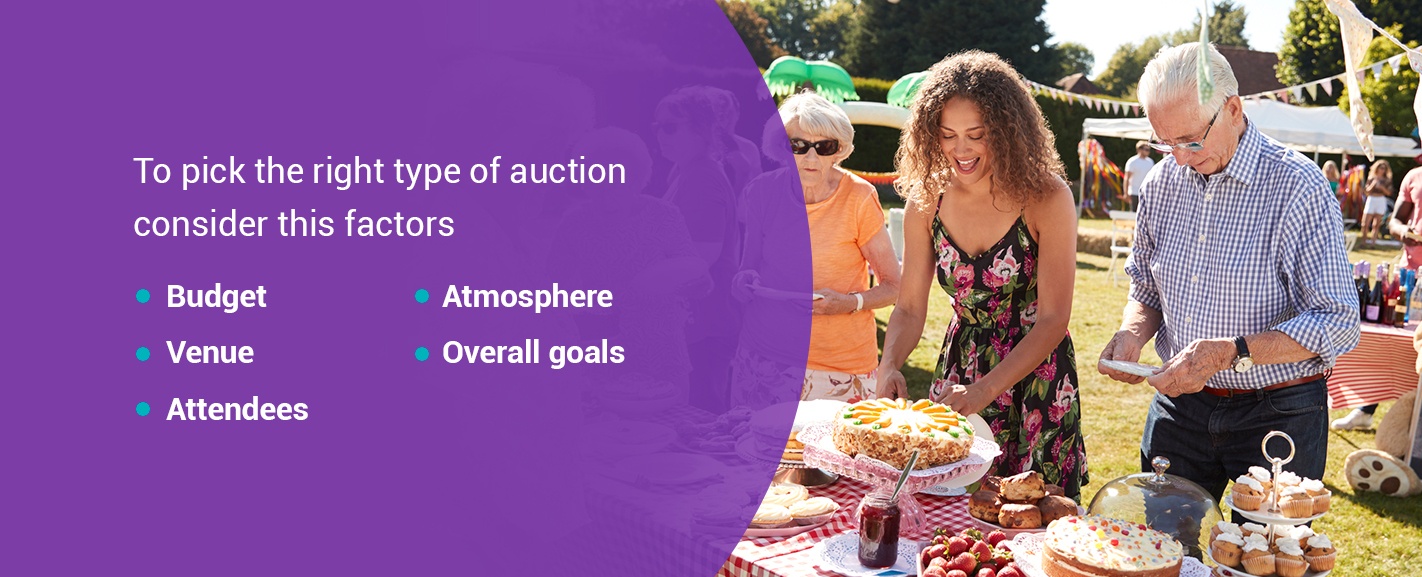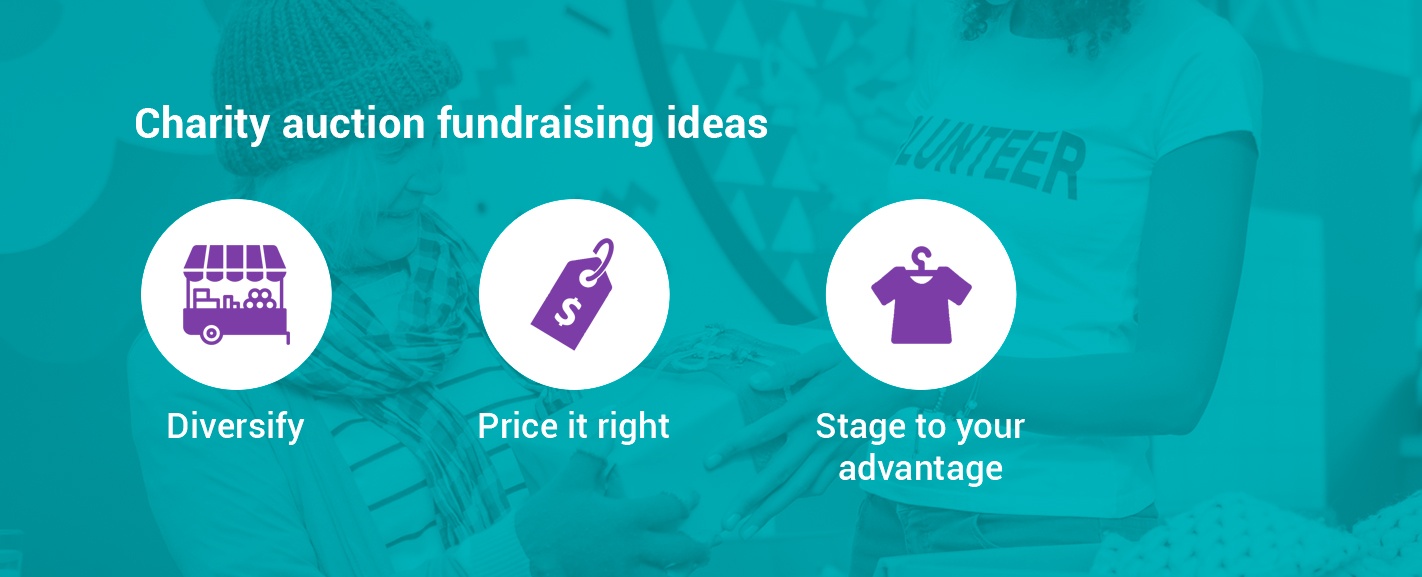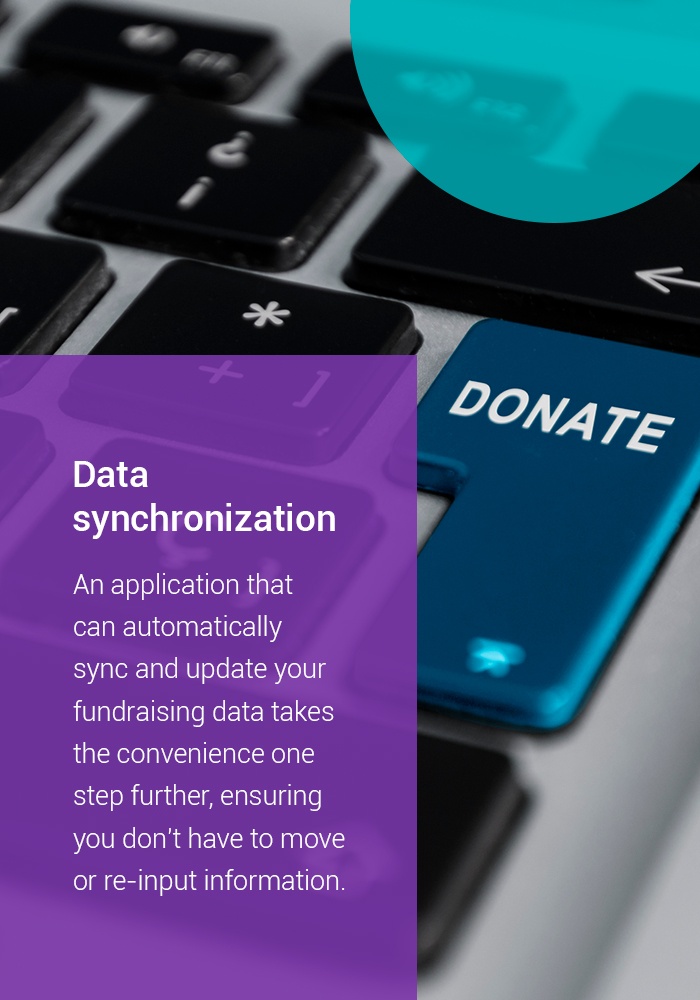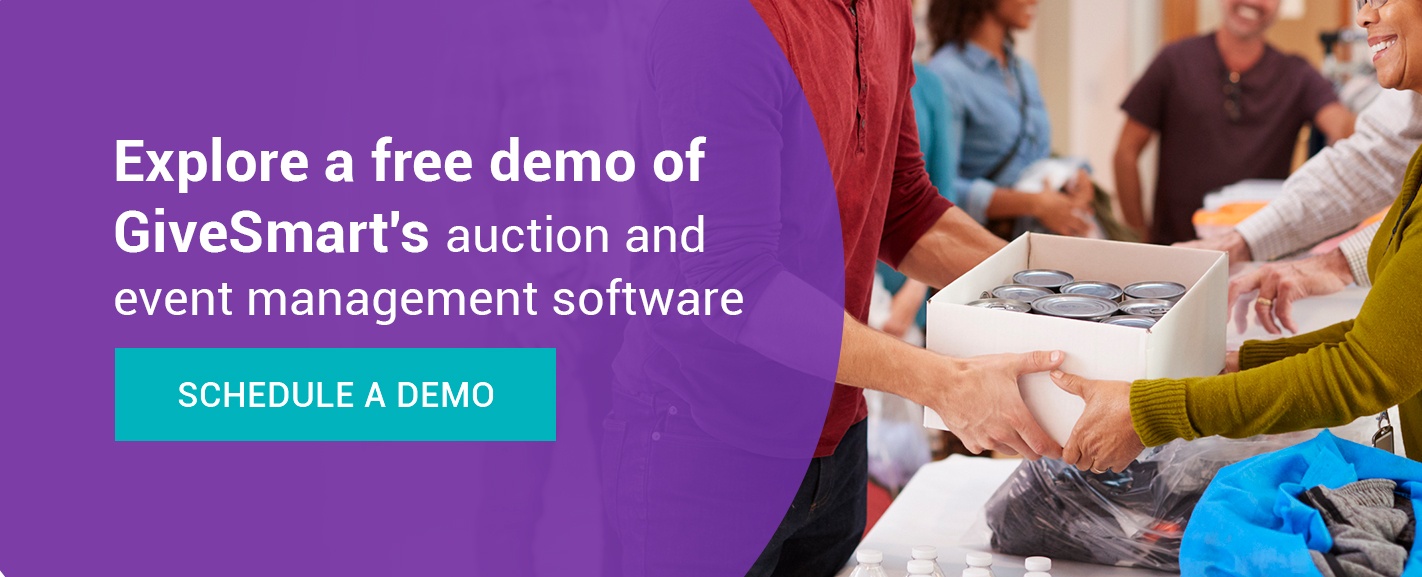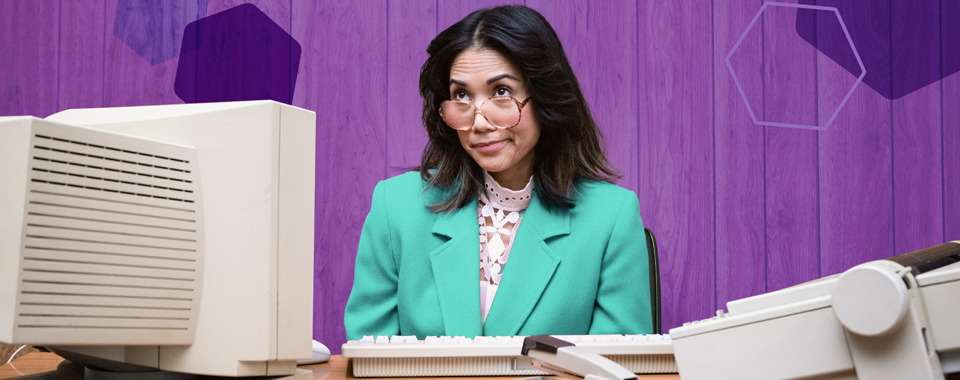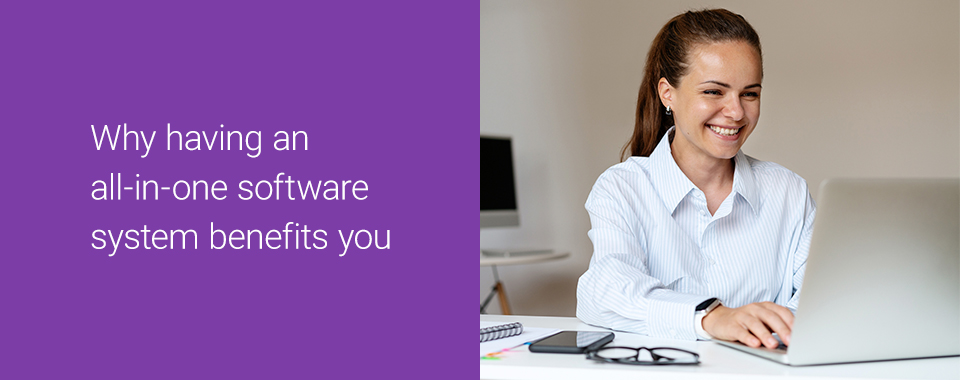Jan 6, 2020
Charity auction fundraising software

Think that traditional, expensive, black-tie charity auction is the only option for your nonprofit’s major fundraising event? Think again.
Silent and mobile auction software lets you reimagine fundraising in the modern world — and for the modern donor, one who’s tech-savvy and open to smartphone-based philanthropy such as online bidding for a good cause.
See how charity auction software fits into your fundraising strategy with this guide, plus learn what to look for in your best mobile auction platform.
How to Get Started With Charity Auction Fundraising
How to Plan for a Charity Auction
Charity Auction Fundraising Ideas
Importance of Software for Charity Auctions
Charity Auction Software Features
NonProfit Charity Auction Software
How to get started with charity auction fundraising
There are three types of auctions available as nonprofit fundraising vehicles. Each event type comes with pros and cons, which you must thoughtfully address to host the most meaningful — and profitable — fundraiser.
1. Live auction
Live auctions feature paddle bidding on select items brought to a stage and curated via an emcee or professional auctioneer. Items come with a pre-determined starting price you and your staff assign, then increase in increments you set. Conversely, you can allow attendees to free bid, raising bids in increments of their choosing.
- Pros: Engaging, high-energy atmosphere. Live paddle bidding creates a sense of urgency, which likely increases the bid amounts on items.
- Cons: Live formats only work featuring a select number of high market-value items. This sense of exclusivity drives up final bids, yet also increases expectations of the prizes up for auction, meaning more stress and pressure on your procurement team. Live auctions are also the most expensive to host.
2. Silent auction
Silent auctions arrange all items on decorated tables for attendees to browse. Attendees then write bids on pre-printed and labeled sheets near desired items, with each subsequent offer attempting to beat the last one written. The final bidder takes home the prize.
- Pros: Social, free-flowing atmosphere, with guests able to peruse auction items at comfortable speeds. Also allows for a greater mix of specialty, high-market-value goods alongside easier-to-procure prizes and merchandise.
- Cons: Requires high attendance to generate the same amount of competitive bids as other auction formats, plus still courts many of the same costs and logistical planning stages as a live auction.
3. Online/mobile auction
Online and mobile auctions take bidding online. Rather than buying tickets and attending a one-day or one-night event, guests register online via your charity auction’s website or app. After submitting their credit card and contact information, they get the opportunity to bid on a wide variety of items featured in an online catalog.
- Pros: Turns your fundraising borderless, since anyone with an internet connection can “attend” your event. Mobile and online auctions can also be the most cost-effective fundraising vehicle, since they eliminate many traditional event-planning functions.
- Cons: Sacrifices that energetic, competitive buzz, as well as the personalization that comes with in-person events. They still require planning, plus special digital tools to arrange and administer mobile auctions.
How to plan for a charity auction
Follow these early steps in your charity auction planning checklist to set your event up for success.
1. Assess logistics to pick the right type of auction
One specific auction format may be calling your nonprofit’s name. However, the type of auction that jumps immediately to mind may not be the wisest for your nonprofit’s fundraising needs or financial flexibility. Consider factors such as the following.
- Budget: Typical fundraising auction expenditures include booking a venue, hiring an emcee or auctioneer, catering, beverages, music and decor, plus miscellaneous expenses associated with back-office event administration.
- Venue: Does your nonprofit hold the right space for an upbeat social gathering, or will you need to book an external venue?
- Attendees: How many invites do you plan to send? What channels will you use to promote your fundraising auction, and will you charge an entry or RSVP fee?
- Atmosphere: Live auctions usher an innate competitiveness and sense of urgency that is missing in silent or mobile events. However, silent auctions are autonomous and flexible, while online ones are the most inclusive and widest-reaching, allowing anyone, anywhere, to bid.
- Overall goals: If your auction’s sole objective is to raise money, any format will do. However, if you’re looking to increase nonprofit brand awareness, recruit fresh volunteers or expand your network on top of fundraising, in-person events may take priority.
2. Determine your fundraising goal
Set your fundraising goal for your auction. Make sure to broadcast that amount across event promotions, highlighting exactly where funds will be going — in other words, why you’re having a fundraiser to begin with. Keeping donation impact at the forefront of your promotional messaging inspires engagement and creates transparency with all participants.
3. Procure audience-relevant items
Items up for auction go for their highest amounts when they fit two key characteristics.
- Range of prizes: From travel and entertainment experiences to household goods, equipment, popular services, sports merchandise, artwork and more, there should be something for everyone.
- Range of prices: Ensure you also have appropriately priced items available at various bid tiers.
Allot a generous amount of time for item procurement. Acquiring desirable items for people to bid on is one of the most pivotal aspects of your fundraiser, and you should start doing so at least nine to 12 months in advance. Likewise, keep your eyes open for different ways to procure items for a charity auction, including assistance from your board of directors, donations from personal connections and writing solicitation letters to area businesses. The latter will likely be your largest source of item donations.
4. Set up charity auction software
Charity auction software serves as your central planning tool. It organizes the vast majority of planning information and documents, while also facilitating other essential online auction functions, such as:
- Auction item procurement
- Online catalog creation
- Mobile bidding for silent auctions
- Tax receipt and documentation generation
- Auction event communications
- Real-time data analytics
5. Promote, promote, promote
Broadcast your auction across all your communication channels. Create targeted campaigns on social media and in strategic print publications to get the word out to ideal attendees, as well as share promotions with your current personal and professional networks. Consider using these campaigns to tease unique aspects of the event, as well as high-value items in your catalog to garner greater interest.
6. Assign staff to specific functions
Keep organization smooth and efficient by assigning nonprofit staff and volunteers to specific planning teams. Top roles to plan a team around include:
- Event logistics
- Item procurement
- Advertising and promotion
- Volunteer management
7. Streamline record-keeping
Create a system between staff to document major auction logistics. Doing so assures everyone is up to speed and informed on all tasks related to preparing your action, whether online or in person.
Charity auction software makes streamlined record-keeping easier. Look for applications that can create and save:
- Registration and event ticket data
- Auction item ticketing and the final event catalog
- Tax receipts
- Participant thank-yous
- Vendor paperwork
Charity auction fundraising ideas
Items up for auction can make or break the success of your fundraising figures. As these goods and services represent your event’s premier revenue generators, keep in mind the following auction item procurement best practices.
- Diversify: Mix and match physical goods with local services, dining opportunities and unique experiences. Diversifying the prizes up for bidding ensures all types of guests will find something attractive, as well as boost the professionalism and reputability of your auction event.
- Price it right: Bid amounts traditionally start at 30 to 50% of an item’s market value. Do your research when assigning starting bids to your complete auction catalog, being honest and transparent about those pricing values.
- Stage to your advantage: You’ve likely heard the expression, “You eat with your eyes first.” Turns out, we bid with them, too. Pay attention to auction item staging. Well-organized, decorative staging draws donors to merchandise and keeps them browsing tables longer. The same logic works online, too, where high-quality photos with professional-sounding, detailed descriptions will drive higher traffic and bids.
Continue reading below for a charity auction planning guide that includes some of today’s hottest — and highest-bid-on — auction items.
1. Big-ticket items
Big-ticket auction items are those with the highest market values.
Many event planners agree these valuable items work best when up for live auction, or promoted in featured, limited-time-only spots across your online event. In either case, given their value, you’ll want to limit the number of big-ticket items up for auction. Experts generally recommend between eight and 12 of these items, depending on your event’s attendee count. The sense of scarcity will drive up bids and increase total fundraising revenue.
What are some examples of the best charity auction items with a higher asking price? Consider:
- All-inclusive travel packages
- Transportation vouchers for airlines, trains, etc.
- Custom artwork
- Signed sports memorabilia
- Personal trainer/nutritionist package
- Gas for a year
- Timeshares
- Pet boarding/pet sitting
- Vouchers from an accredited childcare center
- Commissioned home or business mural
- Electronics such as laptops, smartphones, smartwatches, etc.
- High-end home appliances like an espresso machine
- State-of-the-art grill
- Jewelry
2. Experiential auction ideas
Experiential prizes balance out the physical merchandise adorning your tables or mobile auction pages. They’re especially relevant if your event shifts toward a younger demographic, including millennial and Gen Z attendees. Research shows these generations are more likely to spend on experiences rather than physical goods, meaning a well-rounded auction must prioritize offering one-of-a-kind moments for winners.
- Event tickets to plays, comedy, concerts, sports events, live TV shows, etc.
- Skills/professional development courses
- Financial and life coaching sessions
- Private lessons for golf, piano, etc.
- Cooking and tasting classes
- Bar or restaurant crawls
- All-expenses-paid date night
- Historic building/neighborhood/city tours
- Personal makeover experience
- Dance lessons
- Pedal tavern party
3. Popular charity auction items
Physical products, prizes and goodies make up the bulk of merchandise arranged at silent and online auctions. These tangible items can also go up for live bidding curated by your auctioneer. Just remember, live auction items work best for high market-value items, the ones people are more likely to up-spend on. Use a live auction’s or limited-time-only page’s fast-paced, competitive atmosphere to solidify ticketed item prices and raise the most funds.
Consider any of these prize ideas perfect for online or live-auction bidding, as well as featured items during a silent auction.
- Themed baskets
- Seasonal merchandise
- Home and lawn care products and services
- Vintage wines and spirits
- Micro-brew basket
- International treats
- Luggage
- Oil change/car servicing vouchers
- Catering or delivery, such as lunch delivered to the office for a week
- Musical instruments
- Family photography session
- Home security suite
- Pre-paid annual subscription for entertainment media like Netflix, Amazon, Hulu, etc.
- Emergency car kit
- Tools
- Spice sets and other kitchen gadgets
- High-end dishware, such as cut crystal glasses
Consider creating additional fundraising moments at your auction. Besides bidding on auctioned prizes, you can treat your guests to extra games and activities across the event. While increasing fundraiser revenue, these experiential add-ons also boost the event’s atmosphere, increase engagement and helping create signature moments attendees won’t easily forget.
The importance of software for successful charity auctions
The design of nonprofit event fundraising software allows staff to manage their fundraising initiatives better. By centralizing many of the planning functions involved in putting together a charitable fundraiser, you can execute planning and logistics in less time. That means expedited administrative work, allowing you and your staff to re-focus on higher-value, non-automating tasks, such as item procurement and creative donor engagement.
Nonprofit auction and event management tools bring many benefits.
- Software makes your life easier: Event-management platforms streamline nearly all auction functions, from event RSVPs, check-ins and registration to providing donor tax receipts and facilitating attendee thank-yous. See more tasks this software can take off your shoulders.
- Software informs better decisions: Many nonprofit event management tools contain live, real-time-updating dashboards. These visuals help you effortlessly track fundraising goals, sources and timelines — including across simultaneous campaigns — then re-position stronger strategies next year.
- Software creates a user-friendly donor experience: Difficulties across the donation experience can turn would-be donors away from your organization. Quality charitable fundraising software has a user-friendly interface that’s easily shareable and navigable for the public, so you never have to worry about disgruntled online donors again.
The most important charity auction software features
With all the pieces of nonprofit software to choose from, how do you know you’re getting the right tool for your auctions? Vet fundraising software smarter by prioritizing these features, each of which is instrumental for easier auction planning.
1. Designed for nonprofits
There’s plenty of general event management software on the market. However, many are for commercial event planners. That means software likely lacks nonprofit-industry specific designs and features, including:
- Secure online donation portal
- Text-to-give integrations and mobile-bidding platforms
- Event-specific sponsor/donor databases
- Electronic donation or auction bid receipts for compliant tax purposes
- Personalized text and email communication templates
Pick a fundraising suite designed specifically for nonprofits, assuring you get the convenience of an off-the-shelf product with the precise features you need.
2. Cloud-based and mobile-responsive
Cloud-based applications allow you to access your software anywhere you have an internet connection. Mobile-responsive means you can gain that access on your phones and tablets, not just your office desktop. Better yet, vet mobile bidding charity auction software, ensuring you have access to the world of public mobile bidding for silent auctions.
3. Dashboard reports
Track fundraising quotas, campaigns and sources to determine trends in your online fundraising efforts. Use that same dashboard’s data to tweak current fundraising initiatives, share insights with fellow staff or to re-strategize fundraising ideas for next year.
4. Data synchronization
The best fundraising software works as a central platform. That means all individual tools, databases and features are available in one central location, open for use as soon as you log in. An application that can automatically sync and update your fundraising data takes that convenience one step further, ensuring you don’t have to move or re-input information such as donor information manually from one program or document to another. The software does this for you.
5. Communication portal
Charity auction management software should support essential guest communications. These include, but are not limited to, factors such as the following.
- Event invites/RSVPs: Automatically update your logistics databases with the most accurate event headcount.
- Event registration: Let donors purchase auction tickets online, then have their information stored in your system instantly.
- Auction check-in and check-out: Formally open and close your online auction’s mobile bidding.
- Text and email notifications and communications: Keep your nonprofit top of mind around critical fundraising deadlines, as well as before and after a major event.
6. Bidding and payment integration
Deploy a safe donation and payment platform, making donor contributions effortless. A user-friendly auction and event software design is paramount here, with minimum fields and obstacles ensuring anyone can navigate to make their donation or set their online bid quickly, yet securely.
7. Item management
Make item procurement and ticketing easier with auction software built with an item management tool. This application allows you to upload item photos or images, create descriptions and add buy/bid buttons all from one page — not several.
8. Event seating/floor plan management
For live and silent auctions, opt for event fundraising software with a built-in event seating program. Mix and match table or chair arrangements, assign guest seating, check final headcounts and more, sometimes as easily as using a customizable drag-and-drop floor plan interface.
Try nonprofit auction management software
Explore a free demo of GiveSmart’s auction and event management software created for nonprofits’ unique fundraising needs, including one of the most advanced mobile bidding and online silent auction software solutions in the industry.
Related

